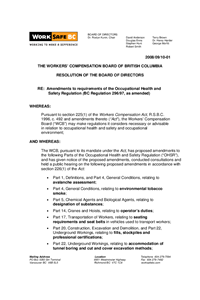BOD Decision – 2008/09/10-01 – Amendments to Requirements of the Occupational Health and Safety Regulation
Complete Resolution
At its September 2008 meeting, WorkSafeBC’s Board of Directors approved amendments to Parts 1, 4, 5, 14, 17, 20, 22, and 23 of the Occupational Health and Safety Regulation. A strikethrough version of the approved amendments with explanatory notes can be accessed below.
- Part 1, Definitions, and Part 4, General Conditions, relating to avalanche assessment
- Part 4, General Conditions, relating to environmental tobacco smoke
- Part 5, Chemical Agents and Biological Substances, relating to designation of substances
- Part 14, Cranes and Hoists, relating to operator’s duties
- Part 17, Transportation of Workers, relating to seating requirements and seat belts in vehicles used to transport workers
- Part 20, Construction, Excavation and Demolition, and Part 22, Underground Workings, relating to fills, stockpiles and professional certifications
- Part 23, Oil and Gas, relating to snubbing operations, emergency escape system, riding hoisting equipment, and miscellaneous items
2021-10-12 20:24:33

